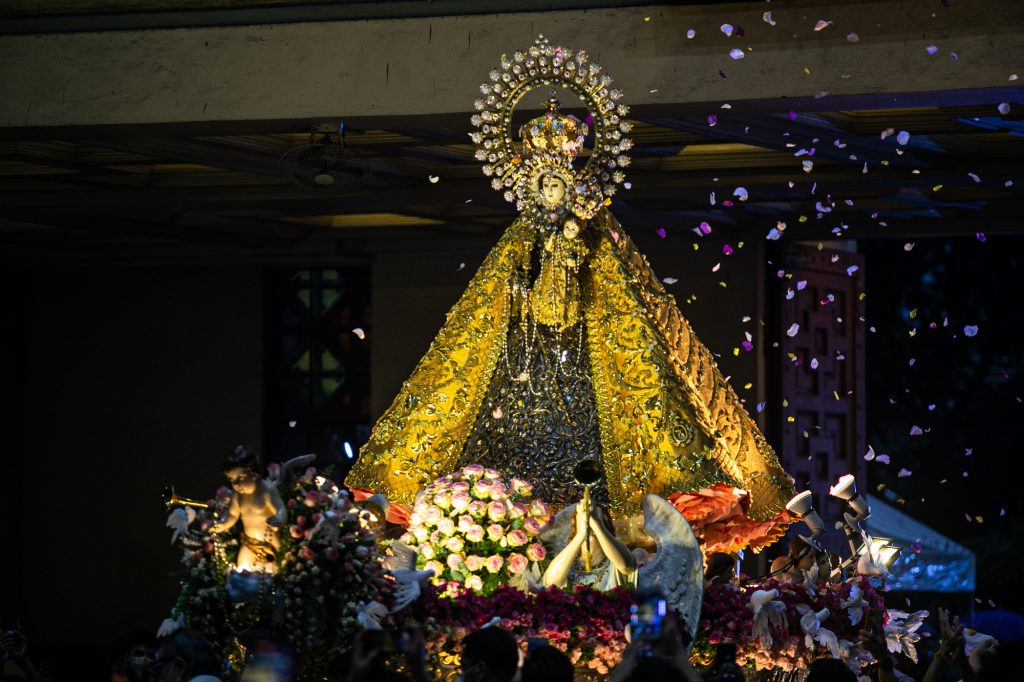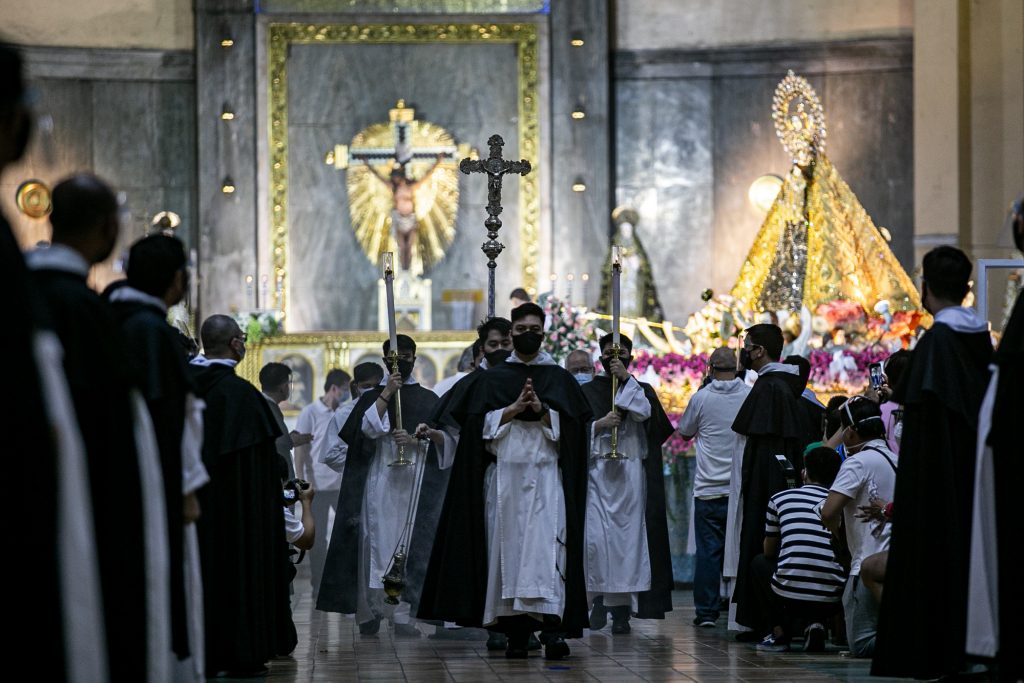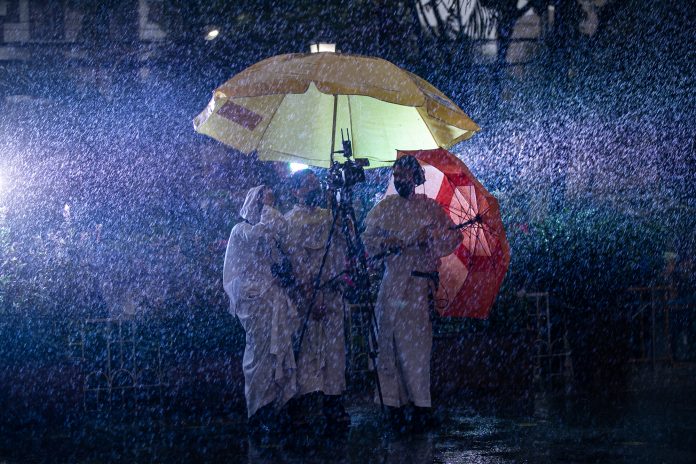For the first time in so many years, the Philippine capital did not hold a religious procession in honor of the Our Lady of the Most Holy Rosary, also known as the La Naval de Manila, during her feast on Sunday, October 11.
The feast of the “Our Lady of La Naval de Manila” is one of the highlights of the annual celebration of the Month of the Holy Rosary in the predominantly Catholic Philippines.
The “Our Lady of La Naval de Manila” is both a title and an image of the Blessed Mother venerated in the Philippines.
Filipinos Catholics credit her intercession for successfully repulsing the Protestant Dutch invasion during the Battles of La Naval de Manila in 1646 and as a turning point for the country to remain a “bastion of Catholicism.”
The image has been venerated by various pontiffs, most notably by St. Pope Pius X, who granted the image a Canonical Coronation in 1907.
In 2009, the Philippine government designated the image and its shrine as a National Cultural Treasure of the Philippines making it one of the country’s “cultural properties.”
Every year, during the second Sunday of the month of October, thousands of devotees join a religious procession in honor of the Blessed Mother.
This year, however, there was no grand procession due to the coronavirus pandemic.
Church leaders, however, brought the image of the Virgin Mary outside the Santo Domingo Church in Quezon City after Mass celebrated by Bishop Honesto Ongtioco of Cubao.

The so-called “dungaw,” or “glimpse,” of the Blessed Virgin allowed the faithful to venerate and pray to the Lady from a distance.
Church officials said it has been a practice in the past to bring out the image of the Blessed Virgin May during special occasions and during times of affliction.
“During times of affliction the Dominican friars would bring out the image of the Our Lady of the Most Holy Rosary for the people to venerate,” said one church official.
“The image is being brought out to tell the people the Virgin Mary is with them in this journey,” he added.
During the “dungaw,” the faithful prayed the rosary.
The image was brought back inside the church after an hour.
The Dominican friars at the Santo Domingo church has been holding the “dungaw” since April amid the pandemic.
Be like Mary
In his homily during Mass, Bishop Honesto Ongtioco of Cubao urged the faithful to pray the Holy Rosary and “be like Mary … a fountain of hope.”
The prelate said Filipino Catholics can be “a source of renewed strength” in healing the country amid the coronavirus pandemic.
“Like Mary, we can be conduits of hope, welfare, and goodness. We can also serve as a channel towards unity through prayers,” he added.
Bishop Ongtioco said a lot of people, including devotees of the Blessed Virgin Mary are suffering because of the coronavirus pandemic.
He said the crisis, which already claimed thousands of lives, is expected to bring more suffering and pain to the people, especially the poor and the vulnerable.
The prelate, however, said that Filipinos can emerge from the crisis “if we will unite in responding to God’s plan like what the Blessed Virgin Mary did.”

“Our Mother is our model on how we will answer to the plan of the Creator… Like Mary, we are called to submit ourselves to God’s plan,” he said.
Bishop Ongtioco said “many Catholics are losing hope while others are angry because of the lockdown. They are asking when are we going to go back to the normal.”
The prelate reminded the public that “this is not the first time” the world suffers because of a pandemic.
“Let us remember that the children at Fatima suffered and two of them died because of a pandemic,” he said.
The prelate, however, stressed that despite the ordeal due to the crisis, the children in the apparition of Mary in Fatima “offered their suffering and pain to God.”
“Through the Eucharist, Sister Lucia prayed on the hidden Jesus. She said, ‘Lord, I join you in your sadness because of the sins of the world,’” said the prelate.
“And because they were affected by an epidemic, she offered her ordeal for the forgiveness of sins,” he added.
Bishop Ongtioco said the devotion to the Our Lady of the Holy Rosary of La Naval de Manila “invites us to offer our ordeal and urges us to unite with God’s plan.”
“I hope that everyone will acquire a devotion as strong as Mary’s fiat. I hope we are strong enough to be like Mary,” said the prelate.
Historial devotion
Historically, the month of October, being the Month of the Rosary in the Philippines, villages across the country celebrate the feast in honor of the Blessed Virgin Mary.
The Catholic Church observes October 7 as the feast day dedicated by Pope St. Pius V, a Dominican, to the Lady of the Rosary as an act of thanksgiving for having saved Europe from invading Moors at the Battle of Lepanto in October 1571.
The celebration took a different context in the Philippines after combined Filipino and Spanish forces battled the Dutch in 1646 in Manila Bay.
Filipino Catholics believe that the Virgin’s intercession under this title helped repulse the invading forces.
The faithful also credit the Virgin, through the icon, with maintaining the Catholic faith in the Philippines, which has the religious moniker “El Pueblo Amante de María.”
The statue of the Virgin, carved from ivory by a Chinese sculptor, was a gift to the Dominicans in Manila by the Spanish governor-general in 1593.
Manila’s high society and devotees have venerated the image ever since.
Mark Saludes contributed to this report









